Mapping Bumblebee Community Assemblages and Their Associated Drivers in Yunnan, China
Simple Summary
Abstract
1. Introduction
2. Materials and Methods
2.1. Study Site and Data Collection
2.2. Habitat Suitability Assessment Using Species Distribution Modeling and Other Statistical Analysis
3. Results
3.1. Habitat Suitability with the Contribution of Bioclimatic and LULC Drivers to Spatial Distribution
3.2. Bumblebee Community Assemblage Zones
3.3. Environmental Drivers of Bumblebee Community Assemblages in Yunnan, China
4. Discussion
5. Conclusions
Supplementary Materials
Author Contributions
Funding
Institutional Review Board Statement
Informed Consent Statement
Data Availability Statement
Acknowledgments
Conflicts of Interest
References
- Katumo, D.M.; Liang, H.; Ochola, A.C.; Lv, M.; Wang, Q.-F.; Yang, C.-F. Pollinator Diversity Benefits Natural and Agricultural Ecosystems, Environmental Health, and Human Welfare. Plant Divers. 2022, 44, 429–435. [Google Scholar] [CrossRef]
- Abrol, D.P.; Mondal, A.; Shankar, U. Importance of Bumble Bees for Crop Pollination and Food Security. J. Palynol. 2021, 57, 9–37. [Google Scholar]
- Marshall, L.; Biesmeijer, J.C.; Rasmont, P.; Vereecken, N.J.; Dvorak, L.; Fitzpatrick, U.; Francis, F.; Neumayer, J.; Ødegaard, F.; Paukkunen, J.P.T.; et al. The Interplay of Climate and Land Use Change Affects the Distribution of EU Bumblebees. Glob. Chang. Biol. 2018, 24, 101–116. [Google Scholar] [CrossRef] [PubMed]
- Rouabah, A.; Rabolin-Meinrad, C.; Gay, C.; Therond, O. Models of Bee Responses to Land Use and Land Cover Changes in Agricultural Landscapes—A Review and Research Agenda. Biol. Rev. 2024, 99, 2003–2021. [Google Scholar] [CrossRef]
- Naeem, M.; Liu, M.; Huang, J.; Ding, G.; Potapov, G.; Jung, C.; An, J. Vulnerability of East Asian Bumblebee Species to Future Climate and Land Cover Changes. Agric. Ecosyst. Environ. 2019, 277, 11–20. [Google Scholar] [CrossRef]
- Naeem, M.; Rani, A.; Lyu, W.; Zhao, H.; Riasat, M.; Abbas, S.; Hussain, S.; Bashir, N.H.; Li, Q.; Chen, H. Temperature-Related Bioclimatic Variables Play a Greater Role in the Spatial Distribution of Bumblebee Species in Northern Pakistan. Insects 2024, 16, 1. [Google Scholar] [CrossRef] [PubMed]
- Morin, P.J. Community Ecology; John Wiley & Sons: Hoboken, NJ, USA, 2009; ISBN 1444312316. [Google Scholar]
- Dovey, K.; Ristic, M. Mapping Urban Assemblages: The Production of Spatial Knowledge. J. Urban. Int. Res. Placemaking Urban Sustain. 2017, 10, 15–28. [Google Scholar] [CrossRef]
- Anderson, M.; Comer, P.; Grossman, D.; Groves, C.; Poiani, K.; Reid, M.; Schneider, R.; Vickery, B.; Weakley, A. Guidelines for Representing Ecological Communities in Ecoregional Conservation Plans. Nat. Conserv. 1999, 74. [Google Scholar]
- Williams, P.H. Can Biogeography Help Bumblebee Conservation? Eur. J. Taxon. 2023, 890, 165–183. [Google Scholar] [CrossRef]
- Williams, P.H. Mapping Variations in the Strength and Breadth of Biogeographic Transition Zones Using Species Turnover. Proc. R. Soc. B 1996, 263, 579–588. [Google Scholar]
- Ernst, R.; Rödel, M.-O. Patterns of Community Composition in Two Tropical Tree Frog Assemblages: Separating Spatial Structure and Environmental Effects in Disturbed and Undisturbed Forests. J. Trop. Ecol. 2008, 24, 111–120. [Google Scholar] [CrossRef]
- Gardner, T.A.; Ribeiro-Júnior, M.A.; Barlow, J.O.S.; Ávila-Pires, T.C.S.; Hoogmoed, M.S.; Peres, C.A. The Value of Primary, Secondary, and Plantation Forests for a Neotropical Herpetofauna. Conserv. Biol. 2007, 21, 775–787. [Google Scholar] [CrossRef]
- Naeem, M.; Chen, H.; Li, W.; Hughes, A.C.; Williams, P.H.; Bashir, N.H.; Miao, Z.; Huang, J.; An, J. Patterns and Drivers of Bumblebee Diversity in Gansu. Insects 2024, 15, 552. [Google Scholar] [CrossRef]
- Tommasi, N.; Pioltelli, E.; Biella, P.; Labra, M.; Casiraghi, M.; Galimberti, A. Effect of Urbanization and Its Environmental Stressors on the Intraspecific Variation of Flight Functional Traits in Two Bumblebee Species. Oecologia 2022, 199, 289–299. [Google Scholar] [CrossRef]
- Butler, R.G.; Lage, C.; Dobrin, S.E.; Staples, J.K.; Venturini, E.; Frank, J.; Drummond, F.A. Maine’s Bumble Bee (Hymenoptera: Apidae) Assemblage—Part 1: Composition, Seasonal and Regional Distribution, and Resource Use. Environ. Entomol. 2021, 50, 1344–1357. [Google Scholar] [CrossRef]
- Yang, Y.; Tian, K.; Hao, J.; Pei, S.; Yang, Y. Biodiversity and Biodiversity Conservation in Yunnan, China. Biodivers. Conserv. 2004, 13, 813–826. [Google Scholar] [CrossRef]
- Stork, N.E. How Many Species of Insects and Other Terrestrial Arthropods Are There on Earth? Annu. Rev. Entomol. 2018, 63, 31–45. [Google Scholar] [CrossRef] [PubMed]
- Yu, T.T.; Chang, Z.; Dong, Z.W.; Li, K.Q.; Ma, F.Z.; Wang, W.; Li, X.Y. A Glimpse into the Biodiversity of Insects in Yunnan: An Updated and Annotated Checklist of Butterflies (Lepidoptera, Papilionoidea). Zool. Res. 2022, 43, 1009–1010. [Google Scholar] [CrossRef] [PubMed]
- Myers, N.; Mittermeier, R.A.; Mittermeier, C.G.; Da Fonseca, G.A.B.; Kent, J. Biodiversity Hotspots for Conservation Priorities. Nature 2000, 403, 853–858. [Google Scholar] [CrossRef] [PubMed]
- Dormann, C.F.; Elith, J.; Bacher, S.; Buchmann, C.; Carl, G.; Carré, G.; Marquéz, J.R.G.; Gruber, B.; Lafourcade, B.; Leitão, P.J. Collinearity: A Review of Methods to Deal with It and a Simulation Study Evaluating Their Performance. Ecography 2013, 36, 27–46. [Google Scholar] [CrossRef]
- Phillips, S.J.; Anderson, R.P.; Schapire, R.E. Maximum Entropy Modeling of Species Geographic Distributions. Ecol. Modell. 2006, 190, 231–259. [Google Scholar] [CrossRef]
- Phillips, S.J.; Dudík, M. Modeling of Species Distributions with Maxent: New Extensions and a Comprehensive Evaluation. Ecography 2008, 31, 161–175. [Google Scholar] [CrossRef]
- Merow, C.; Smith, M.J.; Silander, J.A., Jr. A Practical Guide to MaxEnt for Modeling Species’ Distributions: What It Does, and Why Inputs and Settings Matter. Ecography 2013, 36, 1058–1069. [Google Scholar] [CrossRef]
- Giordani, P. Principal Component Analysis. In Encyclopedia of Social Network Analysis and Mining; Springer: Berlin/Heidelberg, Germany, 2018; pp. 1831–1844. ISBN 149397131X. [Google Scholar]
- Davies, D.L.; Bouldin, D.W. A Cluster Separation Measure. IEEE Trans. Pattern Anal. Mach. Intell. 2009, 2, 224–227. [Google Scholar] [CrossRef]
- Caliński, T.; Harabasz, J. A Dendrite Method for Cluster Analysis. Commun. Stat. Methods 1974, 3, 1–27. [Google Scholar] [CrossRef]
- Rousseeuw, P.J. Silhouettes: A Graphical Aid to the Interpretation and Validation of Cluster Analysis. J. Comput. Appl. Math. 1987, 20, 53–65. [Google Scholar] [CrossRef]
- Charre-Medellín, J.F.; Ferrer-Ferrando, D.; Monterrubio-Rico, T.C.; Fernández-López, J.; Acevedo, P. Using Species Distribution Modeling to Generate Relative Abundance Information in Socio-politically Unstable Territories: Conservation of Felidae in the Central-western Region of Mexico. Ecol. Evol. 2023, 13, e10534. [Google Scholar] [CrossRef] [PubMed]
- Orr, M.C.; Hughes, A.C.; Chesters, D.; Pickering, J.; Zhu, C.D.; Ascher, J.S. Global Patterns and Drivers of Bee Distribution. Curr. Biol. 2021, 31, 451–458.e4. [Google Scholar] [CrossRef] [PubMed]
- Knops, J.M.H.; Tilman, D.; Haddad, N.M.; Naeem, S.; Mitchell, C.E.; Haarstad, J.; Ritchie, M.E.; Howe, K.M.; Reich, P.B.; Siemann, E. Effects of Plant Species Richness on Invasion Dynamics, Disease Outbreaks, Insect Abundances and Diversity. Ecol. Lett. 1999, 2, 286–293. [Google Scholar] [CrossRef]
- Morpurgo, J.; Huurdeman, M.A.; Oostermeijer, J.G.B.; Remme, R.P. Vegetation Density Is the Main Driver of Insect Species Richness and Diversity in Small Private Urban Front Gardens. Urban For. Urban Green. 2024, 101, 128531. [Google Scholar] [CrossRef]
- Le Lann, C.; Wardziak, T.; Van Baaren, J.; van Alphen, J.J.M. Thermal Plasticity of Metabolic Rates Linked to Life-history Traits and Foraging Behaviour in a Parasitic Wasp. Funct. Ecol. 2011, 25, 641–651. [Google Scholar] [CrossRef]
- Stephens, D.W.; Brown, J.S.; Ydenberg, R.C. Foraging: Behavior and Ecology; University of Chicago Press: Chicago, IL, USA, 2008; ISBN 0226772659. [Google Scholar]
- Stahlschmidt, Z.R.; Jodrey, A.D.; Luoma, R.L. Consequences of Complex Environments: Temperature and Energy Intake Interact to Influence Growth and Metabolic Rate. Comp. Biochem. Physiol. Part. A Mol. Integr. Physiol. 2015, 187, 1–7. [Google Scholar] [CrossRef] [PubMed]
- Venujayakanth, B.; Dudhat, A.S.; Swaminathan, B.; Anurag, M.L. Assessing crop genetic diversity using principle component analysis: A Review. Trends Biosci. 2017, 10, 523–528. [Google Scholar]
- Naeem, M.; Huang, J.; Zhang, S.; Luo, S.; Liu, Y.; Zhang, H.; Luo, Q.; Zhou, Z.; Ding, G.; An, J. Diagnostic Indicators of Wild Pollinators for Biodiversity Monitoring in Long-Term Conservation. Sci. Total Environ. 2020, 708, 135231. [Google Scholar] [CrossRef]
- Pérez-Sánchez, A.J.; Schibalski, A.; Schröder, B.; Klimek, S.; Dauber, J. Local and Landscape Environmental Heterogeneity Drive Ant Community Structure in Temperate Seminatural Upland Grasslands. Ecol. Evol. 2023, 13, e9889. [Google Scholar] [CrossRef]
- Murtagh, F.; Legendre, P. Ward’s Hierarchical Clustering Method: Clustering Criterion and Agglomerative Algorithm. arXiv 2011, arXiv:1111.6285. [Google Scholar]
- Ward, J.H., Jr. Hierarchical Grouping to Optimize an Objective Function. J. Am. Stat. Assoc. 1963, 58, 236–244. [Google Scholar] [CrossRef]
- Iwasaki, J. Interactions Between Bee Species in Relation to Floral Resources. Ph.D. Thesis, University of Otago, Otago, New Zealand, 2017. [Google Scholar]
- Legendre, P.; Legendre, L. Numerical Ecology; Elsevier: Amsterdam, The Netherlands, 2012; ISBN 0444538690. [Google Scholar]
- Lozier, J.D.; Strange, J.P.; Heraghty, S.D. Whole Genome Demographic Models Indicate Divergent Effective Population Size Histories Shape Contemporary Genetic Diversity Gradients in a Montane Bumble Bee. Ecol. Evol. 2023, 13, e9778. [Google Scholar] [CrossRef]
- Galaiduk, R.; Halford, A.R.; Radford, B.T.; Moore, C.H.; Harvey, E.S. Regional-scale Environmental Drivers of Highly Endemic Temperate Fish Communities Located within a Climate Change Hotspot. Divers. Distrib. 2017, 23, 1256–1267. [Google Scholar] [CrossRef]
- Fourcade, Y.; Åström, S.; Öckinger, E. Climate and Land-Cover Change Alter Bumblebee Species Richness and Community Composition in Subalpine Areas. Biodivers. Conserv. 2019, 28, 639–653. [Google Scholar] [CrossRef]
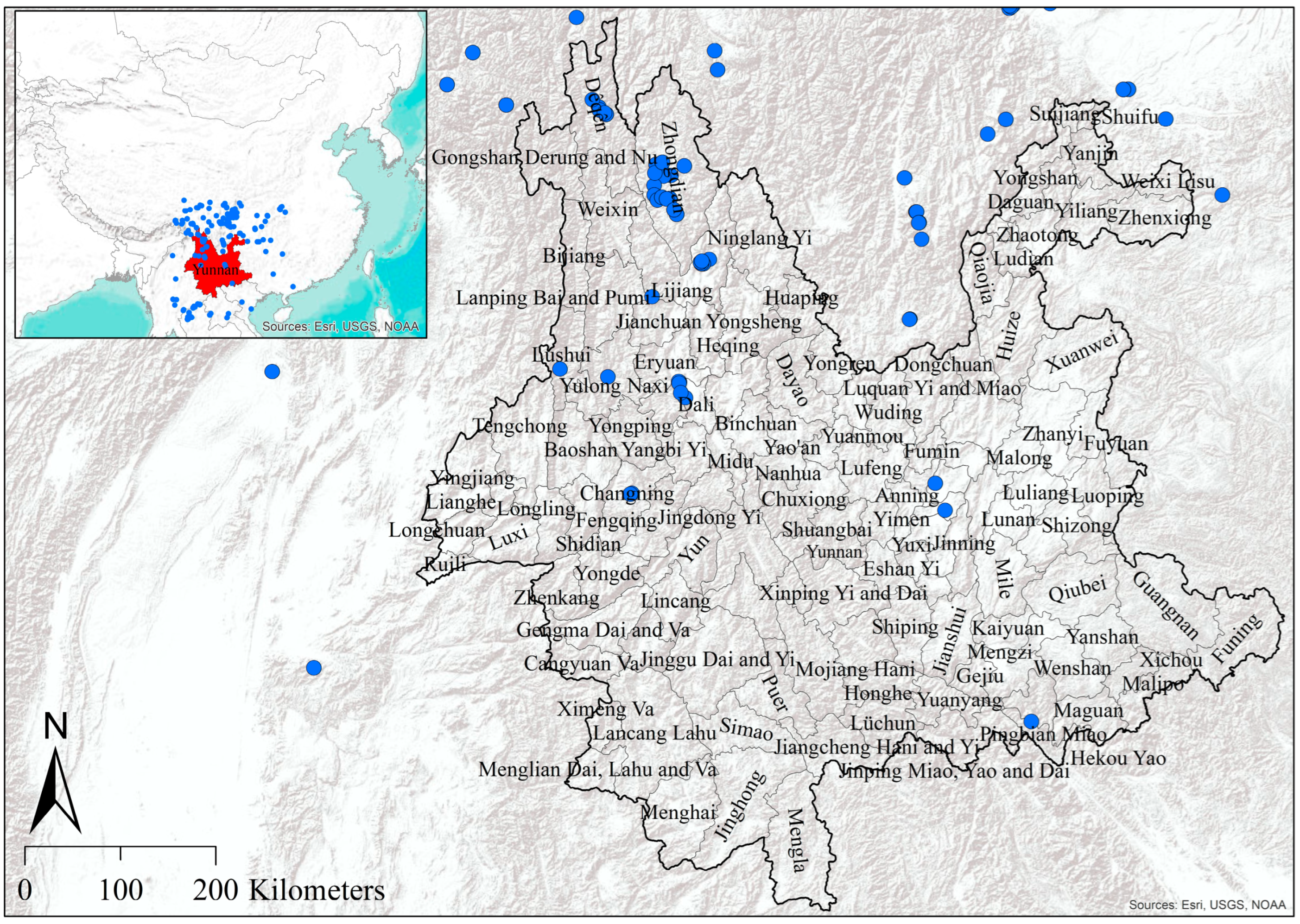
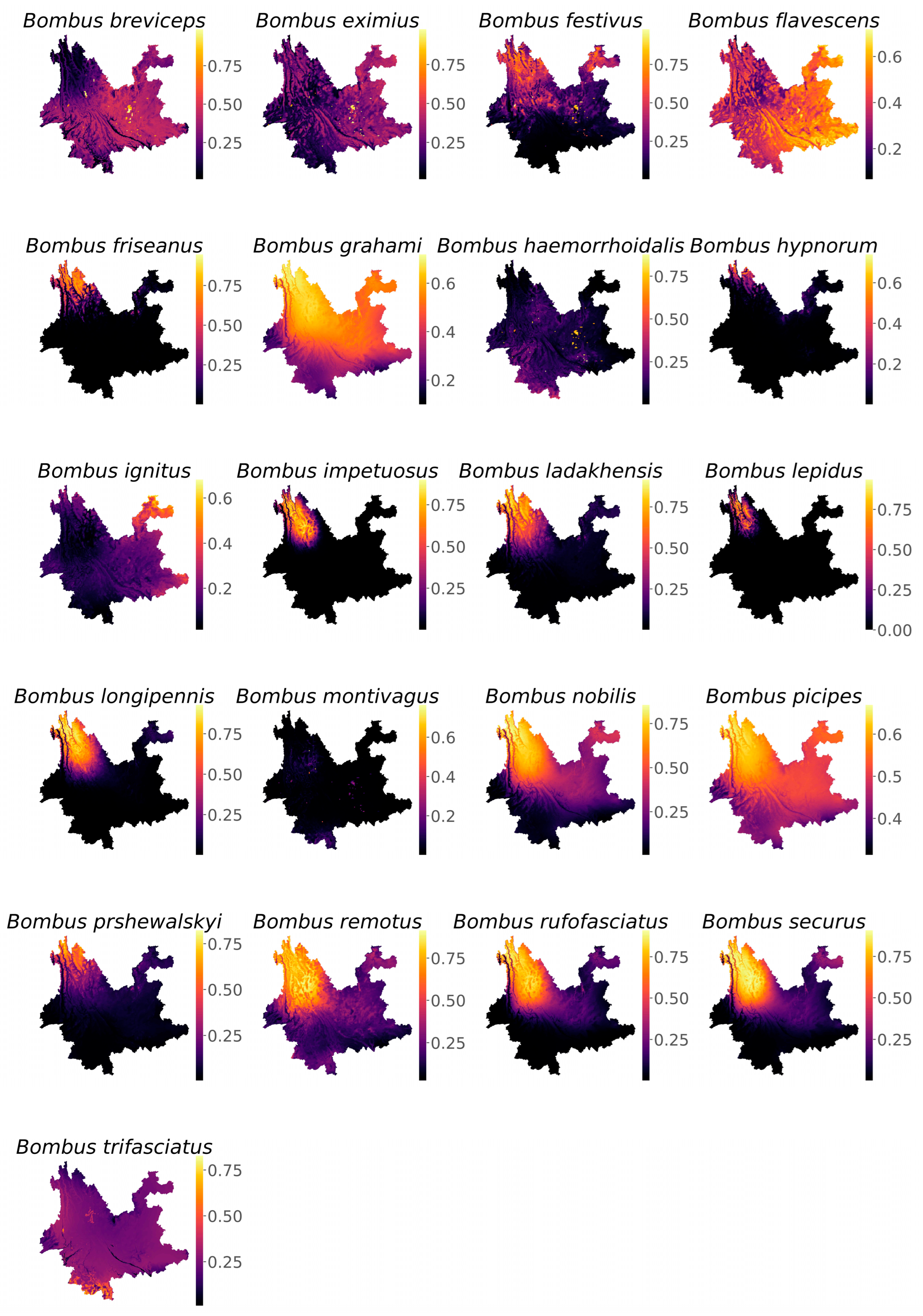
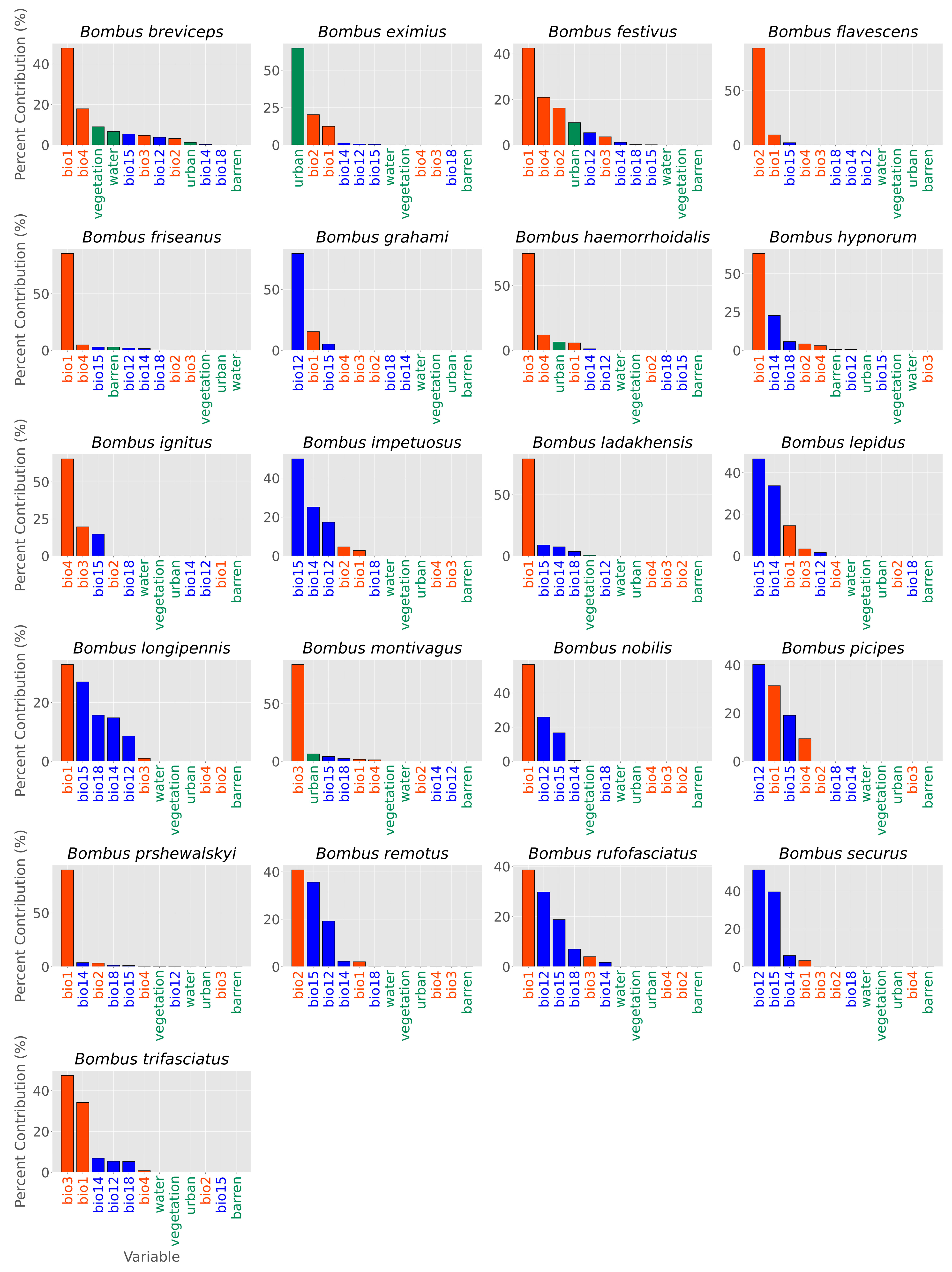
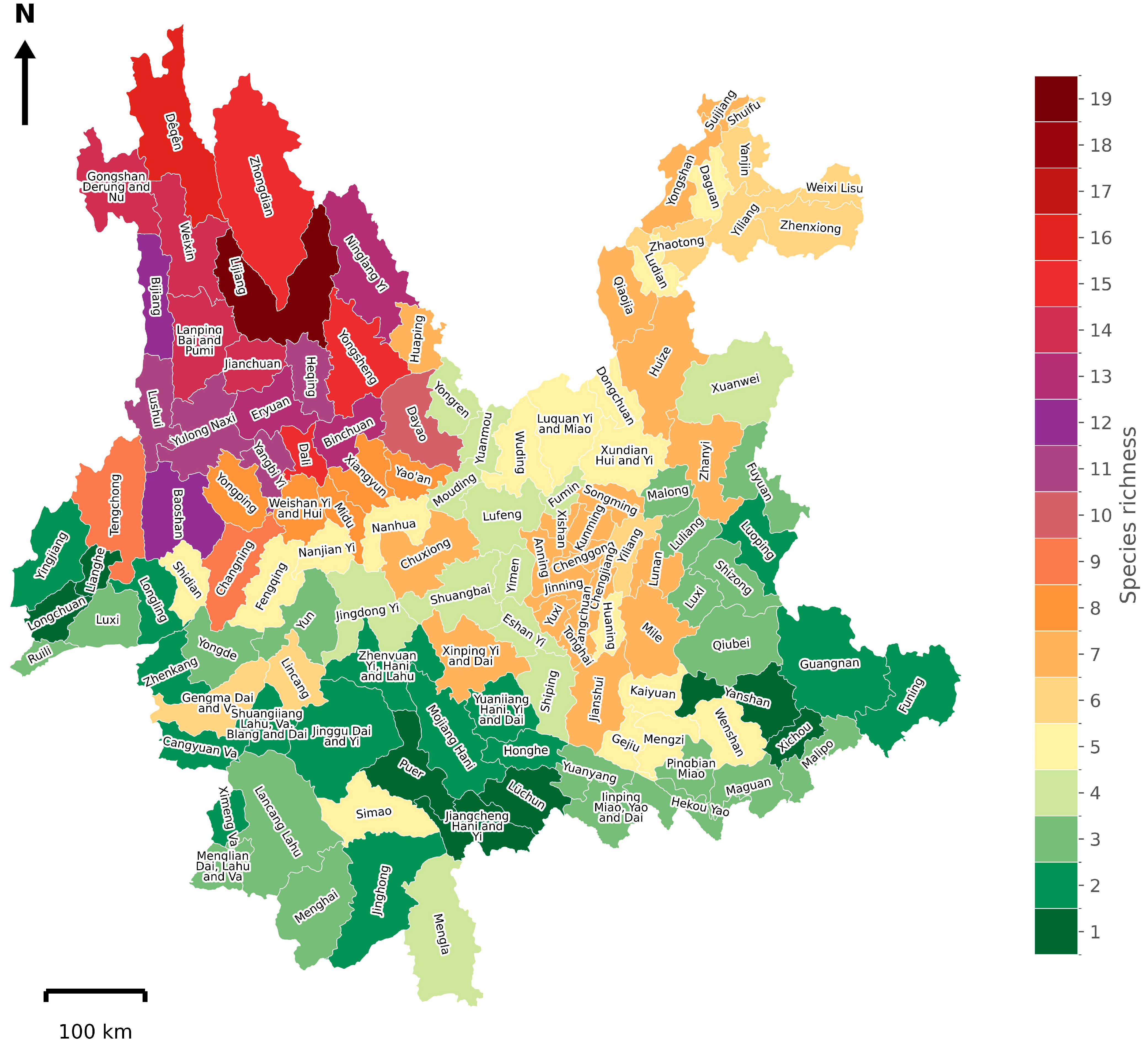

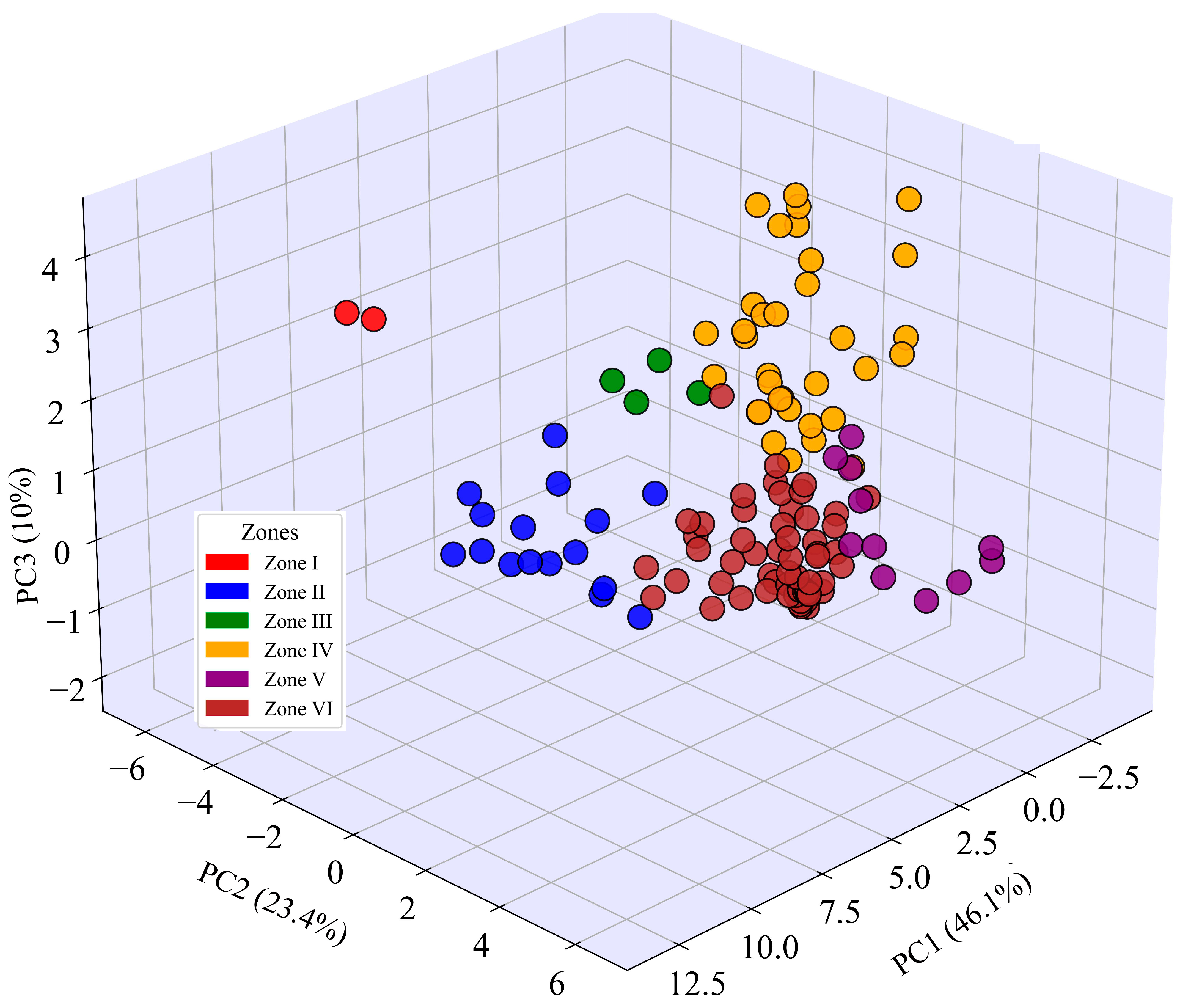

| Environmental Drivers | Axis 1 of CCA Plot | Axis 2 of CCA Plot |
|---|---|---|
| bareland | −0.03 | −0.38 |
| bio1 | 0.83 | 0.39 |
| bio2 | −0.64 | 0.44 |
| bio3 | 0.10 | 0.88 |
| bio4 | −0.43 | −0.83 |
| bio12 | 0.63 | 0.04 |
| bio14 | 0.19 | 0.11 |
| bio15 | 0.82 | −0.10 |
| bio18 | 0.74 | −0.02 |
| urban | −0.06 | −0.18 |
| vegetation | 0.18 | 0.35 |
| water | −0.51 | −0.24 |
Disclaimer/Publisher’s Note: The statements, opinions and data contained in all publications are solely those of the individual author(s) and contributor(s) and not of MDPI and/or the editor(s). MDPI and/or the editor(s) disclaim responsibility for any injury to people or property resulting from any ideas, methods, instructions or products referred to in the content. |
© 2025 by the authors. Licensee MDPI, Basel, Switzerland. This article is an open access article distributed under the terms and conditions of the Creative Commons Attribution (CC BY) license (https://creativecommons.org/licenses/by/4.0/).
Share and Cite
Chen, H.; Naeem, M.; Meng, L.; Bashir, N.H.; Riasat, M.; Liu, Z.; Pan, C. Mapping Bumblebee Community Assemblages and Their Associated Drivers in Yunnan, China. Biology 2025, 14, 1222. https://doi.org/10.3390/biology14091222
Chen H, Naeem M, Meng L, Bashir NH, Riasat M, Liu Z, Pan C. Mapping Bumblebee Community Assemblages and Their Associated Drivers in Yunnan, China. Biology. 2025; 14(9):1222. https://doi.org/10.3390/biology14091222
Chicago/Turabian StyleChen, Huanhuan, Muhammad Naeem, Licun Meng, Nawaz Haider Bashir, Maryam Riasat, Zichao Liu, and Canping Pan. 2025. "Mapping Bumblebee Community Assemblages and Their Associated Drivers in Yunnan, China" Biology 14, no. 9: 1222. https://doi.org/10.3390/biology14091222
APA StyleChen, H., Naeem, M., Meng, L., Bashir, N. H., Riasat, M., Liu, Z., & Pan, C. (2025). Mapping Bumblebee Community Assemblages and Their Associated Drivers in Yunnan, China. Biology, 14(9), 1222. https://doi.org/10.3390/biology14091222






